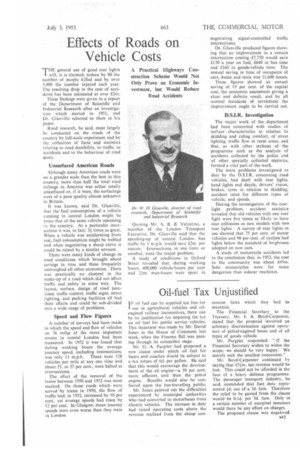Effects of Roads on Vehicle Costs
Page 101

If you've noticed an error in this article please click here to report it so we can fix it.
A Practical Highways Construction Scheme Would Not Only Prove an Economic Investment, but Would Reduce Road Accidents T"Egeneral use of good rear lights will, it is claimed, reduce by 80 the number of people killed and by over 3,000 the number injured each year. The resulting drop in the cost of accidents has been estimated at over f2m.
These finding's were given in a report of the Department of Scientific and Industrial Research after an investigation which started in 1951, and Dr. Glanville referred to them in his paper.
Road research, he said, must largely be conducted on the roads of the country by full-scale experiment and by the collection of facts and statistics relating to road durability, to traffic, to accidents and to the behaviour of road
Unsurfaced American Roads
Although many American roads were on a grander scale than the best in this country, more than half the total road mileage in America was either totally unsurf aced or, if it were, the surfacing& were of a poor quality almost unknown in Britain.
It was known, said Dr. Glanville, that the fuel consumption of a vehicle running in central London might be twice that of the same vehicle operating in the country. At a particular intersection it was, in fact, 3i times as great. When a vehicle was accelerating from rest, fuel consumption might be trebled and when negotiating a sharp curve it could be raised by a similar amount There were many kinds of change in road conditions which brought about savings in time and these frequently outweighed all other economies. There was practically no element in the make-up of a road which did not affect traffic and safety in some way. The layout, surface, design of road junctions, traffic control, traffic signs, street lighting, and parking facilities all had their effects and could be sub-divided into a wide range of problems.
Speed and Flow Figures
A number of surveys had been made in which the speed and flow of vehicles on 36 miles of the more important streets in central London had been measured. In 1952 it was found that during working hours the average journey speed, including intersections, was only 11 m.p.h. There were 128 vehicles per mile at any one time and about 25, or 27 per cent., were halted at intersections.
The effect of the removal of the trams between 1950 and 1952 was most marked. On those roads which were served by trams in 1950, the flow of traffic had, in 1952, increased by 10 per cent., yet average speeds had risen by 12 per cent. In Glasgow, mean journey speeds were even worse than they were in London Quoting Mr. A, B. B. Valentine, a member of the London Transport Executive, Dr. Glanville said that the speeding-up of central London bus traffic by 1 m.p.h. would save £2m. per annum. Intersections, in one form or another, were the major problem.
A study of conditions in Oxford Street revealed that, during working hours, 400,000 vehicle-hours per year and 21m. man-hours were spent in negotiating signal-controlled traffic intersectinns.
Dr. Glanville produced figures showing that an improvement to a certain intersection costing 17,750 would save £130 a year on fuel, £640 in bus time and /160 in goods-vehicle time. The annual saving in time of occupants of cars, buses and taxis was 11,600 hours.
These figures showed an annual saving of 19 per cent. of the capital cost, the economic assessment giving a clear and definite result, and by all normal standards of investment the improvement ought to be carried out.
D.S.I.R. Investigation
The major work of the department had been concerned with studies of surface characteristics in relation to skidding and riding comfort, of street lighting, traffic flow in rural areas, and that, as with other sections of • the programme such as the analysis of accidents collected by the police and of other specially collected statistics, formed a vital part of the work.
The main problems investigated to date by the D.S.I.R. concerning road vehicles, had dealt with rear lights, head lights and dazzle, drivers' vision, brakes, tyres in relation to skidding, accident rates for different types of vehicle, and speeds..
During the investigation of the rear light • problem, accident statistics revealed that old vehicles with one rear light were five times as likely to have rear collisions as new models with two rear lights. A survey of rear lights in use showed that 75 per cent. of motor vehicles and 98 per cent. of cyclists had lights below the standard of brightness adopted on new cars.
A study of motorcycle accidents led to the conclusion that, in 1952, the cost to the community was about 145m. Solo motorcycles were far more dangerous than sidecar machines.




























































































































































